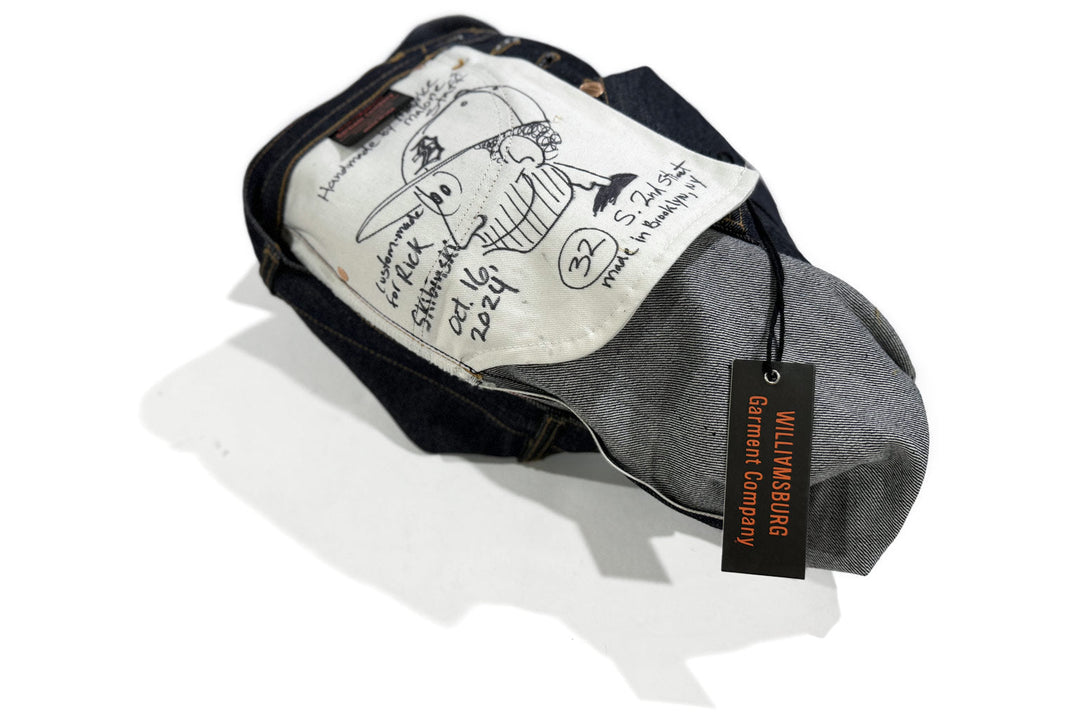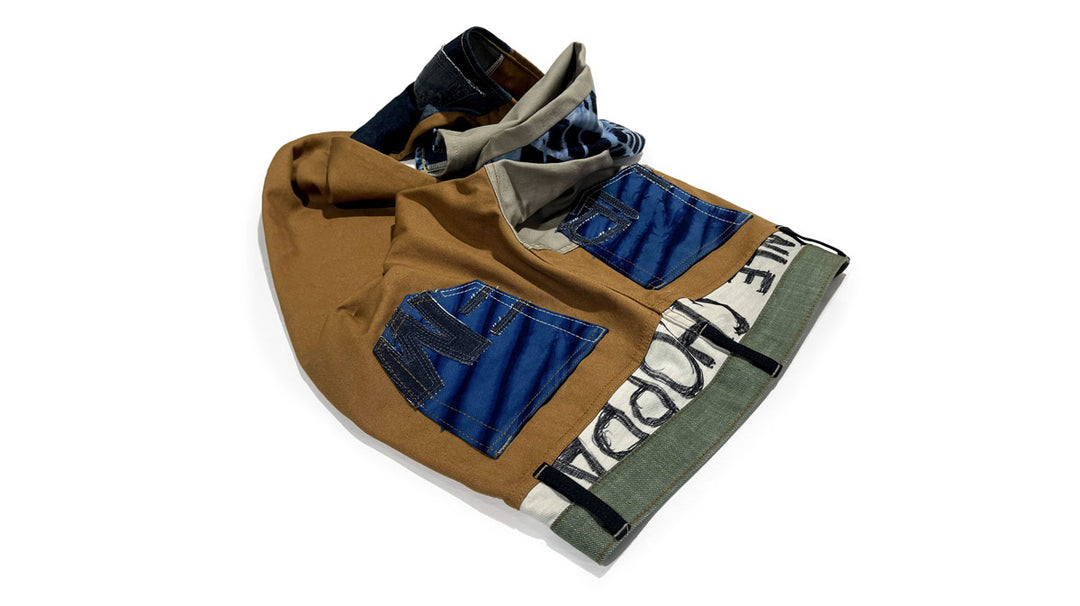Has any African American done denim longer?

In the early 1980s, since high school, my studio was my mom's basement in Oak Park, Michigan. My cutting table was the pool table covered in plastic. Patterns-in-work taped to the walls. Equipment: one industrial walking foot, one Juki home serger (my first machine), and my mom's home sewing machine. Multiple layers of denim were too tough for my machines to penetrate, so I designed around my limitations. The first denim designs were overalls or jeans made with drawstring waistbands to avoid the fly construction, and I stonewashed them by hand. This was my beginning in denim design.

For Black History Month last year at this time, I started to write this blog post to promote the new History of Hardwear t-shirt, which spotlights my early days in denim. It was never posted, but this year I decided to finish.
Reading over things, I thought, I've been doing this a long time. Then I thought, who was the first notable black denim designer or black-owned denim brand? Nothing came to mind. I Googled various related phrases, still, nothing came up except lots of articles with headlines like "top (fill in the blank) number of black designers or black-owned clothing brands you should know," plus a few shopping sites selling black jeans. Needless to say, I wasn't surprised to see I didn't make anyone's list. I know the industry. It's part who you know and part analytical (how many followers?).
I'm not new, or a celebrity. Not social media focused, I don't have a publicist, and I retired from attending events to remain in the mix of things nearly 15-years ago. Instead, I'm at the Greenpoint, Brooklyn studio of my newest brand Williamsburg Garment Company (WGC), trying to build it into a deep-rooted substantial brand of the future, producing made-in-the-USA jeans in its own factories. Quietly successful since 2012, these days I'm only about making solid denim products. WGC is one of the most respected small-batch American-made denim brands with a long list of selvedge denim enthusiasts who are willing to wait up to an entire year for a pair of autographed custom-made jeans. The brand is also recognized as the top denim alterations specialist in the nation, vastly superior to most tailors and other denim specialists when it comes to jeans and heavyweight workwear.
This subject got me thinking. I'm sure there must have been notable blacks in denim before me? I'm not talking about African American fashion designers who dabble in denim when presenting a collection, or someone on the staff of a brand with no stake. I mean a real denim pro, with expertise in making jeans that have impacted the industry.
The problem was, I could not recall or find any who predated me. When I began, I was inspired by Calvin Klein – posting his jean ads on my walls. Patrick Kelly and Jean-Paul Gautier were my other favorite fashion designers. I can remember Patrick Kelly wearing denim overalls and all his buttons. He dabbled in denim, but clearly, I wouldn't call him a denim designer. Generally, there's rarely any expertise in high-fashion denim. More often than not, it's done poorly but executed with creativity.
Whatever the reason for Blacks missing in the history of denim, it worried me enough that I thought, it was time that I lay out in detail a record of my history. The new t-shirt isn't enough but did spark this conversation.
How I started in denim

How I started in denim? I recall having limitations making jeans and designing around them. What I came up with were unique-looking styles. In my early years I was making jeans without figuring out how to make a zipper fly, so I made overalls that you could step into, jeans with drawstring waistbands, hand-drawn patterned twills, and leather & denim combo striped pants. I would go to my local library to look up manufacturers with hopes to get jeans professionally made. I searched these big Blue Books (used by contractors) which listed manufacturers of all types, and the Yellow Pages of New York, Los Angeles, and cities in Texas, or wherever denim manufacturing was known to be happening in the early 1980s.

I was a kid, a 19-year-old middle-class jobless teenager. I located factories but didn't have the money to produce the required minimum orders or logistic expertise to source and bring all the required parts for production. I was just out of high school, with parents that worked in auto and steel factories. The dream of mass-producing jeans and other clothing was still just a dream for me but pursued it like it was reality.
However, I did learn from my numerous phone calls to denim factories that jeans were washed using pumice stones and liquid chlorine. I did not go to a fashion college. Asking others in business, together with trial and error is how I learned almost everything I know.
This led me to look up rock suppliers. I didn't know which was best, so I ordered bags of both large and small-sized pumice stones and had them shipped to my mom's home. The bags were too big to bring inside, so they sat in the backyard for years. I sought local swimming pool suppliers for liquid chlorine, eventually driving 30-minutes into the suburbs to find it.
In the beginning, I used plain old household bleach to stone wash my designs. Rubbing denim and sometimes a combo of denim with leather against the surface of the concrete tub located in our basement laundry room.
When the pumice stones arrived and liquid chlorine, I upped the game. I stonewashed clothing by hand in the tub, filling it with hot water, bleach, and detergent. With large pumice stones in my hands, I scrubbed the denim, creating worn areas. The smell of the bleach was so intense I had to do this holding my breath, darting in & out of the room for air. The scrubbing would grind down my fingerprints, and the tips of my fingers would burn for days after each wash. As a shortcut, I tried using the smaller stones in my mom's washing machine, as I learned they did at industrial laundries, but my mom was having none of that. The rocks were scratching the inside of her machine, plus the residue was clogging the drainage. She threatened severe punishment if I used her machine again. However, while she was away at work, I would sneak in uses from time to time, very careful to clean up afterward. I took the risk because of the pain and danger associated with doing it by hand.
Introducing Maurice Malone, America's New Generation Designer
At age 19, I started my first company on February 15, 1984. I incorporated the date into the logo. I called the brand Hardwear by Maurice Malone for two reasons. First, I was doing a lot of designs combining metal and denim. The most popular style was my jeans with metal knee pads. They had rectangle sheet metal plates held in place with nuts and bolts. Second, I wasn't so confident about using my name. I had to add something to it. In my mind at the time, the best brands all had European names. Maurice Malone didn't sound like a good designer name to me. I'd often ask other people for their opinion, and overwhelmingly everyone thought my name was great.

Hardwear by Maurice Malone's 2nd national advertisement appeared in the January 1988 issue of Interview Magazine. The ad features me with my long-time pal Jerome Mongo. His parents were up-and-coming entrepreneurs in the city of Detroit. Friends of Mayor Coleman Young, his parents ran popular hair salons plus other downtown businesses and would close doors to the public to attend to artists like Prince when he came into town. Growing up as young entrepreneurs and artists, since teenagers, we'd bounce ideas off each other and debate everything.

End of Part-1
To be continued...









You Rock!!!
I’d love to offer something for your next season.
So Proud of you brother!🙏🏾❤️👍🏾👌🏾
I was there from the beginning. Congratulations on your success my friend
Leave a comment